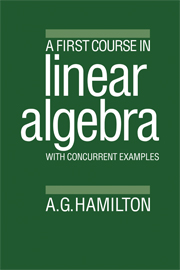Book contents
- Frontmatter
- Contents
- Preface
- 1 Gaussian elimination
- 2 Solutions to simultaneous equations 1
- 3 Matrices and algebraic vectors
- 4 Special matrices
- 5 Matrix inverses
- 6 Linear independence and rank
- 7 Determinants
- 8 Solutions to simultaneous equations 2
- 9 Vectors in geometry
- 10 Straight lines and planes
- 11 Cross product
- Answers to exercises
- Sample test papers
- Further reading
- Index
1 - Gaussian elimination
Published online by Cambridge University Press: 24 October 2009
- Frontmatter
- Contents
- Preface
- 1 Gaussian elimination
- 2 Solutions to simultaneous equations 1
- 3 Matrices and algebraic vectors
- 4 Special matrices
- 5 Matrix inverses
- 6 Linear independence and rank
- 7 Determinants
- 8 Solutions to simultaneous equations 2
- 9 Vectors in geometry
- 10 Straight lines and planes
- 11 Cross product
- Answers to exercises
- Sample test papers
- Further reading
- Index
Summary
We shall describe a standard procedure which can be used to solve sets of simultaneous linear equations, no matter how many equations. Let us make sure of what the words mean before we start, however. A linear equation is an equation involving unknowns called x or y or z, or x1 or x2 or x3, or some similar labels, in which the unknowns all occur to the first degree, which means that no squares or cubes or higher powers, and no products of two or more unknowns, occur. To solve a set of simultaneous equations is to find all values or sets of values for the unknowns which satisfy the equations.
Given two linear equations in unknowns x and y, as in Example 1.1, the way to proceed is to eliminate one of the unknowns by combining the two equations in the manner shown.
Given three linear equations in three unknowns, as in Example 1.2, we must proceed in stages. First eliminate one of the unknowns by combining two of the equations, then similarly eliminate the same unknown from a different pair of the equations by combining the third equation with one of the others. This yields two equations with two unknowns. The second stage is to solve these two equations. The third stage is to find the value of the originally eliminated unknown by substituting into one of the original equations.
- Type
- Chapter
- Information
- A First Course in Linear AlgebraWith Concurrent Examples, pp. 1 - 10Publisher: Cambridge University PressPrint publication year: 1987
- 1
- Cited by



